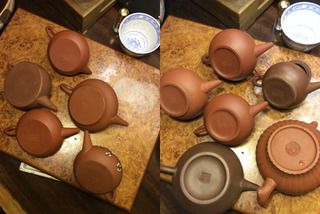In fact, I must correct what I said yesterday. Today I tried the same DHP with another EoT pot, a PingGai made with the hualongshan clay and the results was much better than with the PanHu yesterday.BW85 wrote:I use one of the EoT haunglongshan pots for yancha regularly, it's actually my preferred yancha pot over several others I use occasionally. But it could be due to my personal preference; when drinking yancha I don't care that much about the aroma, its all about mouth feel and body to me. Aside from the wonderful empty cup aroma!xiaobai wrote:I own three pots from EoT (none made of that expensive zini #1 clay though) and never found them to perform exceptionally well with yancha.
Initially, I had obtained bad results using EoT's yancha and a hualongshan
Shi Piao from the same vendor.
The material of the PingGai and the Shi Piao is zini, which appears to me as fired at a higher temperature than the Tian Qing Ni of the PanHu.
The fact that the material of PanHu is probably more porous does not mean that the roasting notes of the DHP get more smoothen out, which probably means that the effect of the clay is secondary (both pots have been used for about the same time, so seasoning should be similar).
In that case, it must be the shape that mainly determines the performance.
In fact, the PingGai has a smaller basal surface than the PanHu, which is much flatter. The volume is slightly different, 80 ml vs 95 ml. But both factors favor a higher heat retention by the PingGai compared to the flatter PanHu.
The above observations would suggest that the thermal properties of the pot are probably the dominant factor and the effect of the clay is secondary as far as those pots are concerned.
"ni" means clay, "sha" means sand. They are not the same thing.BW85 wrote:Zini, zisha... Just words.xiaobai wrote: By the way: FYI, The comparison described on Stephane's tea masters website was not with zini, but old zisha. I happen to know first hand.
